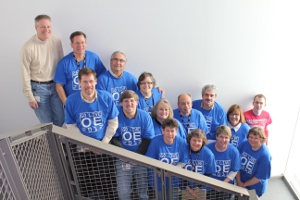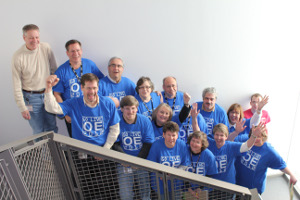
| Jan. 2012 | |||||||||||
| Top stories | |||||||||||
| In the news | |||||||||||
| Photos | |||||||||||
| Contact us | |||||||||||
| Archive | |||||||||||
|
OpenELIS comes home |
An initiative to create an electronic information system for laboratories came full circle on Jan. 1 when the State Hygienic Laboratory launched its first phase of OpenELIS.
This unique enterprise laboratory information system (ELIS) is built on an Open Source platform; hence the name OpenELIS. The original design for the project was started by a team of public health professionals in six states. Versions of the design now are running in three US public health laboratories, in Haiti, Vietnam and The Republic of Côte d'Ivoire (Ivory Coast).
The Open Source platform allows other laboratories to be licensed for use at no charge. The primary caveat associated with this licensing is that all improvements made by any group are to be shared with all users of the system.
"It is collaborative effort, which makes it more robust," said Dari Shirazi, IT director and one of the lead architects of the program. "It is free to all labs or anyone else for that matter. What we are hoping to do in the long term is to build a community. We hope that others come and enhance the code, and bring it back to the community."
Funded by the Robert Wood Johnson Foundation, the Public Health Informatics Institute and the Association of Public Health Laboratories, a group representing public health laboratories in Alaska, Iowa, Kansas, Minnesota, New York and Virginia started the project in 2002. They designed a framework for a modern laboratory information management system and identified the business processes it would need to support.
 |
 |
|
Members of the OpenELIS team gathered to cheer for the launch of the new electronic reporting system are (from left, back row) John Negley, Bill Berger, Dari Shirazi, Marcia Dawson, Marinea Mehrhoff Mike Hayek, David Larabee-Zierath, Michelle Sexton and Dustin May. Pictured in the front row (from left) are Terry Cain, Matt Bielicke, Bev French, Nancy Hall, Sherri Marine and Sarah May. Team members not pictured include Jason Badgett, Steve Bernholtz, Terry Bowman, Amanda Carl, Donna Cole, Frank Delin, Mary DeMartino, Rhonda Drayfahl, Jessica Elliott, Stacy Freeburg, Kathy Hanson, Dennis Heimdal, Sandy Jirsa, Alankar Kampoowale, John Miller, Pam Mollenhauer, Karen Owens, Mike Ramirez, Royce Riessen, Bonnie Rubin, John Schlenker, Travis Schmidt, Mike Schueller, Don Simmons, Kevin Singleman, Becky Teske, Marcia Valbracht, Kevin Van Auken, Jeff Wasson, Brian Wels and Michael Wichman. | |
Midwestern perseverance led the Iowa, Kansas and Minnesota labs in creating the next step: a physical design, which included a database that could be implemented in the laboratories. In 2008, Minnesota State Public Health Laboratory launched the clinical version of OpenELIS. A few months later, Vietnam brought it online.
The Jan. 1 go-live date at the Hygienic Laboratory was a culmination of these broader efforts and also the result of many years of work by laboratory staff and clients. The Iowa Department of Natural Resources, for example, was part of the beta test team that provided critical feedback during the summer of 2011.
An easier, more streamlined approach to accessing information is one of the primary benefits for clients. Without OpenELIS, the Hygienic Laboratory would have continued to operate on a minimum of three separate information systems. That means that if a client sends in samples for newborn screening, clinical testing and environmental testing, they would have to access three separate systems with separate tools. Each unique system requires different training, maintenance and support.
OpenELIS eliminates the need for multiple systems thereby dramatically reducing the need for duplicate steps by clients and staff. Shirazi expects that the Newborn Screening program and the Disease Control Divisions will be added to the system within the next year.
"Designing a system that accommodates all of our processes in one place allows our clients to have access to their information in one place in a uniform fashion," he said. "This is a significant advantage. Also, improvements made to the system based on one client's request can be shared simultaneously with all other clients. So, it's good for our clients and it's good for us."
Other enhancements already incorporated include an email notification system that informs the clients when a sample arrives at the Laboratory. After the test has been processed and results become available, clients receive an email notification that they can view the results online.
"One of things that most programmers want to do is to make the lives of others better," Shirazi said. "We are very proud of our work with OpenELIS. We are hoping that it will significantly benefit public health and improve the quality of life."